- Home
- Barbara Kingsolver
High Tide in Tucson Page 3
High Tide in Tucson Read online
Page 3
I imagine other neighbors: that Georgia O'Keeffe, for example, is out there walking the hills in sturdy shoes, staring down the UPS man with such a fierce eye that he will never dare tell.
What is it that draws creators to this place? Low rent, I tell my friends who ask, but it's more than that. It's the Southwest: a prickly land where mountain lions make bets with rabbits, and rabbits can win. Where nature rubs belly to belly with subdivision and barrio, and coyotes take shortcuts through the back alleys. Here even the rain has gender, the frogs sing carpe diem, and fast teenage girls genuflect quickly toward the door of the church, hedging their bets, as they walk to school in tight skirts and shiny high heels.
When I drive to the post office every few days to pick up my mail, it's only about twelve miles round trip, but I pass through at least half-a-dozen neighborhoods that distinguish themselves one from the other by architecture and language and even, especially, creation myth. First among them is the neighborhood of jackrabbits and saguaros, who imperiously tolerate my home, though I can't speak their language or quite understand their myths.
Then, just inside the city limits, a red cobble of just-alike roofs--paved air--where long strands of exurban condominiums shelter immigrants from Wisconsin, maybe, or Kansas, who dream in green and hug small irrigated lawns to their front doors.
Next I cross the bridge over the Santa Cruz, whose creation story bubbles from ephemeral springs in the mountains of southern Arizona and Mexico. In these lean days she's a great blank channel of sand, but we call her a river anyway, and say it with a straight face too, because in her moods this saint has taken out bridges and houses and people who loved their lives.
Then I pass under the artery of Interstate 10, which originates in Los Angeles or Jacksonville, Florida, depending on your view of destiny; and the railroad track, whose legend is a tale tasting of dynamite, the lives and deaths of immigrants who united a continent and divided in twain the one great original herd of American bison.
Then without warning I am smack in the middle of a Yaqui village that is fringe-edged and small like a postage stamp, and every bit alive. Despite its size, Pascua Yaqui is a sovereign world; I come here every Easter to watch an irresistible pageant combining deer dances with crucifixion. Like the Tohono O'odham singing down the rain, the masked Yaqui dancers listen for the heartbeat of creation, and keep a promise with every vernal equinox to hold the world to its rightful position. On this small patch of dusty ground, the religion of personal salvation is eclipsed by a faith whose question and answer are matters of order in the universe. Religion of that kind can crack your mind open the way lightning splits a pine, leaving the wind to howl through the scorched divide. I can hardly ever even drive through here, in my serviceable old Toyota, without biting my lip and considering immensity.
Calle Ventura marks the entrance to another state, where on a fine, still day your nose can compare the goods from three tortilla factories. From here the sidewalks roll, the walls crumble and shout with territorial inscription, brown dogs lie under cherry Camaros and the Virgin of Guadalupe holds court in the parking lot of the Casa Rey apartments.
Across the street stands the post office, neutral territory: mailboxes all identical, regardless of the keyholder's surname, as physically uniform as a table of contents. We are all equals in the eyes of the USPO, containing our secrets. I grab mine and scuttle away. The trip home takes me right back through all these lands again, all these creation stories, and that's enough culture for one day, usually.
I close the door, breathless, and stare out my window at a landscape of wonders thrown together with no more thought than a rainstorm or a volcano can invoke on its own behalf. It's exactly as John Muir said, as if "nature in wildest extravagance held her bravest structures as common as gravel-piles."
From here I begin my story. I can't think of another place like it.
MAKING PEACE
When I left downtown Tucson to make my home in the desert, I went, like Thoreau, "to live deliberately." I think by this he meant he was tired of his neighbors. For me the problem wasn't specifically my neighbors, whom I loved (and it's a good thing, since our houses were so close together we could lean out our bedroom windows and shake hands), but the kids who spilled over from--and as far as I could see, never actually attended--the high school across the street. They liked rearranging the flowers in my front yard, upside down. They had art contests on my front walk, the point being to see whether a realistic rendition of the male sex organ could be made to span the full sweep from sidewalk to front door. They held very loud celebrations, daily, on my front porch. When my brain was jangled to the limits of reason, I would creep from my writing desk to the front door, poke my head out, and ask if they could turn the music down. They glared, with So What eyes. Informed me this was a party, and I wasn't invited.
The school's principal claimed that kids outside the school grounds were beyond his jurisdiction; I was loath to call the city police, but did (only after the porch party ratified a new sport involving urination), and they told me what I knew they'd say: the principal ought to get those kids in school. My territory was up for grabs, by anyone but me.
After some years had passed and nobody seemed to be graduating, I struck out for Walden. My husband and I sold our house, collected our nerve, and bought four acres of rolling desert--a brambly lap robe thrown over the knees of the Tucson Mountains, a stone's throw beyond the city limits. There was a tiny cabin, which we could expand to suit our needs. I anticipated peace.
Like a pioneer claiming her little plot of prairie, I immediately planted a kitchen garden and hollyhocks outside the door. I inhaled silence, ecstatic with the prospect of owning a place that was really my own: rugged terrain, green with mesquite woods and rich in wildlife. No giant penises waiting to impale me when I threw open my front door. Only giant saguaros. Only bird song and faint hoofprints in the soil, evidence of wild creatures who might pass this way under cover of darkness.
Sure enough they came, the very first night: the javelinas. Woolly pigs. They are peccaries, technically, cloven-hoofed rooters of the New World, native to this soil for much longer than humans have known it--but for all the world they are pigs. I pressed my face to the window when I heard their thumping and rustling. Their black fur bristled as they bumped against one another and snuffled the ground with long, tusked snouts. I watched them eat my hollyhocks one by one.
Pioneering takes patience. I thought maybe that first visit was some kind of animal welcome-wagon tradition in reverse, and that over time we could reach an accord. Night after night, they returned. The accord seemed to be: You plant, we eat. The jackrabbits were hungry too, but I discovered that they shun the nightshade family--which conveniently includes tomatoes and eggplants--and that I could dissuade them from my flowers with chicken wire (although a flowerbed that looks like Fort Knox is a doubtful ornament). Not so picky, the pigs. With mouths of steel and cast-iron stomachs, they relished the nightshades, and in their eagerness I swear they even ate chicken wire. Over the weeks I tried the most pungent flowers I could think of: geraniums, marigolds. They ate everything. Rare is the epicurean pig who has feasted at such a varied table as the one I provided.
I tried to drive them off. Banged on the windows, shrieked, and after a goodly amount of accomplishing nothing whatsoever through those means, cautiously opened the door a crack, stuck my head out, and hollered.
"Shoo, pigs!" said I.
"Not by the hair of my chinny chin chin," thought they, apparently, in what passes for thought within those bony skulls. They ignored me profoundly, inciting me to extremes. I stooped to throwing rocks, and once by the wildest of chances, so help me God, I hit one, broadside. With a rock the size of a softball, and a respectable thud. The victim paused for half an instant midgobble and sniffed the air as if to ask, Was that a change in the weather? Then returned to the hollyhocks at hand. On the He-Man Scale of Strength, my direct hit scored "Weenie." I seethed between the four walls of my
house like Rochester's mad wife in the attic.
In a fit of spite I went to a nursery that specializes in exotics, and brought home an Adenium obesum. This is the beautiful plant whose singularly lethal sap is used by African hunters to poison their darts.
Javelinas understand spite: they uprooted my Adenium obesum, gored it, and left it for dead.
Over the months our house slowly grew, with javelinas watching. We framed up an extra room, which we would eventually connect to the old house by tearing out a window, once it was sealed to the outside. We laid out sheet-metal ductwork, which would go into the ceiling, for heating the new addition. In the middle of the night we woke to the sound of the devil's own celebration: hellacious hoofs on tin drums. The pigs had found their way into the new room and were trampling the ductwork, sending their tinny war cry to the stars above.
Ownership is an entirely human construct. At some point people got along without it. Many theorists have addressed the question of how private property came about, and some have gone so far as to suggest this artificial notion has led us into a mess of trouble. They aren't talking about personal property, like a toothbrush or a digging stick to call one's own, which has probably always been a human tradition. Even a bird, after all, has its nest, and chimpanzees in a part of central Africa where there's a scarcity of nut-smashing tools are known to get possessive about their favorite rocks. But to own land, plants, other animals, more stuff than we need--that is the peculiar product of a modern imagination.
In the beginning, humans were communal and social creatures; this is agreed upon by all scientists who've given our species retroactive study. The habit and necessity of cooperation is what led us, like other social species, toward the development of an elaborate communication system. Other social primates that live in large groups, like Japanese macaques and baboons, communicate with a much richer repertoire of sounds than the solitary primates like orangutans. Many social mammals use not only verbal but olfactory signals--a language of the nose. An example of complex communication among birds, familiar to any rural child, is that of the socially cooperative chickens, who use different calls (in the wild, as well as the barnyard) to refer to important events in their lives: krk krk krk (food over here); kark kark KARK (really good food over here); RRRR-rrrr (hawk overhead). Parrots, another famous category of garrulous birds, are presumed by scientists to have developed their gift of gab because of social habits and longevity in the wild.
It's safe to presume that the most talkative of all primates, Homo sapiens, evolved in the context of cooperative social groups also, hunting and gathering on the African savannahs. The theory that has percolated best into popular imagination is the one that claims men clobbered the animals, providing intermittent jubilations of protein for the home crowd, while women dug roots, picked fruits and seeds, and harvested edible plant parts. The latter activities presumably would provide the bulk of the steady calories, but for many decades the burgeoning science of human origins was captivated by the hunting scenario: the need to peer out over the savannah grass as incentive for walking upright; the necessities of spear making and cooperative hunting giving rise to language, dexterity, and a large, complex brain.
This neat boy-girl theory smacks of sexist backward projection, I've always thought, while I do concede (having carried a toddler on my own hip for a few years) that it's more feasible to go berry picking than lion hunting with a nursing child in tow. But many early anthropologists, unable to resist drama, apparently overestimated the importance of "the hunt" as a shaper of our body, character, and destiny. It's now understood that the earliest evidence of meat eating in the human archaeological record comes from East African sites that are less than two million years old. Considering that we have been walking upright and approximately human for more than twice that long, carnivory may have been an afterthought. Anthropologist Adrienne Zihlman argues that the challenge that shaped us was most likely the savannah environment itself, which is not a monoculture of tall grass but a complex mosaic of grassland, hills, and forested areas along watercourses. Potential food sources were abundant but seasonal and widely scattered; the early human's home range would have been much larger than that of living savannah baboons and chimpanzees. The best survivors would be those with a good locomotor system and the capacity to carry water and food, as well as offspring. Based on the fossil record, and on close study of living hunter-gatherers and our primate relatives in similar habitats, Zihlman has estimated that plant foods, insects, and small vertebrates made up more than 90 percent of the early hominid diet, and that "scavenging and consumption of large dead animals found by chance" was probably infrequent. This scenario, which has our ancestors shooing off hyenas and vultures from the carcass du jour, isn't going to sell any movie rights, but it has the advantage of evidence behind it.
In any case, the best perspective on the notion of a natural division of labor was given me long ago by one of my most influential college professors, Preston Adams, a botanist who studied human evolution. He pointed out that all "man the hunter" theories implicitly establish women as the first botanists. He also liked to tell restless zoology majors that it takes a superlative mind to appreciate a plant. He kindly allowed me to put two and two together.
When it began to dawn on our insightful ancestors that they could save some edible seeds, put them in the ground, and have a whole new edible crop right on the front stoop, we had agriculture on our hands. It's a giant step, the historical materialists maintain, to go from appropriating the products of nature to increasing their supply through human labor. The first evidence of cultivated grains comes from archaeological sites that are in the neighborhood of eleven thousand years old. Joseph Campbell, in his Atlas of World Mythology, identifies at least three independent points of origin for "The Way of the Seeded Earth": the Middle East, Southeast Asia, and Central America. Domestication of animals followed right along. A handful of seeds, like Jack's magic beans, turned our fortunes head over heels.
Friedrich Engels, the nineteenth-century economist and close associate of Karl Marx, examined our history under the bright lamp of a new paradigm set forth by his contemporary Charles Darwin. Engels also had access to the prodigious work of anthropologist Lewis Henry Morgan. Countless modern scholars have addressed the history of private property, but it's hard to beat the elegance of Engels's simple outline of human social evolution, laid out in his wonderful classic, The Origin of the Family, Private Property, and the State. In the natural progression to a more controlled form of hunting and gathering, he theorized, the community efforts of planting and harvesting remained the female domain, while animals that could "belong" to someone belonged to men. Goats and sheep, being mobile and tradable, became currency. Rather suddenly men got the purse strings. Rather suddenly "purse strings" was a concept. So was "inheritance." The family tightened its boundaries, the better to serve as conduit for property passed from father to son.
If we can divine religion from relics, it seems pretty clear that up to this point human societies stood most in awe of female power: the pregnant Venus of Willendorf; the Woman with the Horn carved on a cliff in Dordogne, France; the fecund clay figurines that preclassical Mexicans buried with their dead; pregnant torsos carved from the tusks of woolly mammoths in Asia; the pale stone fertility figures strewed along the Mediterranean coast like so many dragons' teeth. The one that gets my vote for blunt reverence is a mammoth-ivory disk from a gravesite in Moravia, cut with a single, unambiguous vulval slit. So many goddesses, so little time--for they fell, and fell far, from grace. It's pretty difficult now even to imagine female body parts as sacrament: when the kids spray-painted vulvas on my front steps, their thoughts were oh so far from God.
How fiercely doth the sacred turn profane. Our ancestors in the Fertile Crescent appear to have dropped Goddess Mother like a hot rock, and shifted their allegiance to God the Father, coincident with the rise of Man the Owner of the Flock.
Since then, most of us have come to see human
ownership of places and things, even other living creatures, as a natural condition, right as rain. While rights and authority and questions of distribution are fiercely debated, the basic concept is rarely in doubt. I remember arguing tearfully, as a child, that a person couldn't own a tree, and still in my heart I believe that, but inevitably to come of age is to own. When we stand upon the ground, we first think to ask, Whose ground is this? And NO TRESPASSING doesn't just mean, "Don't build your house here." It means: "All you see before you, the trees, the songbirds, the poison ivy, the water beneath the ground, the air you would breathe if you passed through here, the grass you would tread upon, the very idea of existing in this place--all these are mine." Nought but a human mind could think of such a thing. And nought but a human believes it. Javelinas, and teenagers, still hark to the earth's primordial state and the music of the open range.
Now, territoriality is a different matter. Birds do that. Dogs do it. Pupfish in their little corner of a mud puddle do it. They (meaning, usually, the males of territorial species) mark out a little plot and defend it from others of their own kind, for the duration of their breeding season. This is about reproduction: he is making jolly well sure that any eggs that get fertilized, or babies that get raised, within that hallowed territory are, in fact, his own. Often, it's also a matter of securing an area that contains enough resources---nuts, berries, caterpillars, flower nectar, whatever--to raise a brood of young. Just enough, usually, and hardly a caterpillar more. The minute the young have flown away, the ephemeral territory vanishes back into the thin air, or the bird brain, whence it came. The male might return to establish a breeding territory in the same place again next year, or he might not. The landscape lives on, fairly untouched by the process.

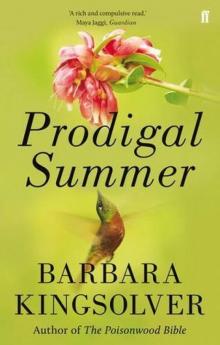 Prodigal Summer: A Novel
Prodigal Summer: A Novel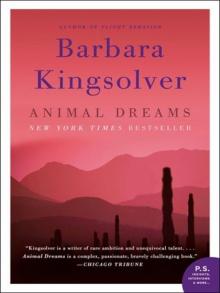 Animal Dreams: A Novel
Animal Dreams: A Novel The Poisonwood Bible
The Poisonwood Bible High Tide in Tucson
High Tide in Tucson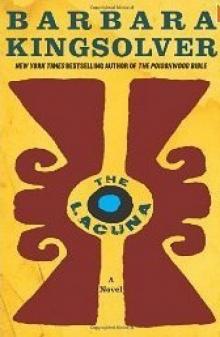 The Lacuna
The Lacuna The Bean Trees
The Bean Trees Animal, Vegetable, Miracle: A Year of Food Life
Animal, Vegetable, Miracle: A Year of Food Life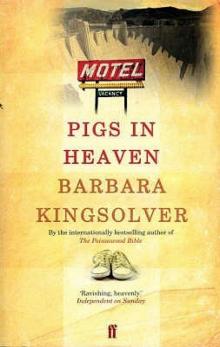 Pigs in Heaven
Pigs in Heaven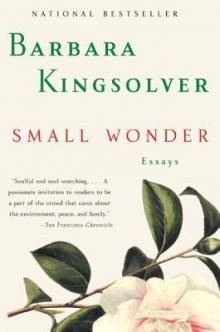 Small Wonder
Small Wonder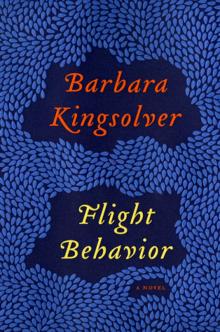 Flight Behavior
Flight Behavior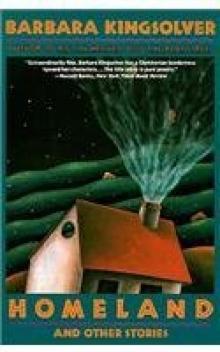 Homeland and Other Stories
Homeland and Other Stories How to Fly (In Ten Thousand Easy Lessons)
How to Fly (In Ten Thousand Easy Lessons) Unsheltered
Unsheltered Animal Dreams
Animal Dreams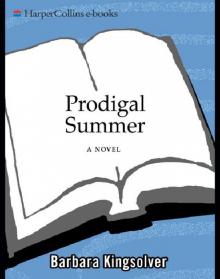 Prodigal Summer
Prodigal Summer Animal, Vegetable, Miracle
Animal, Vegetable, Miracle